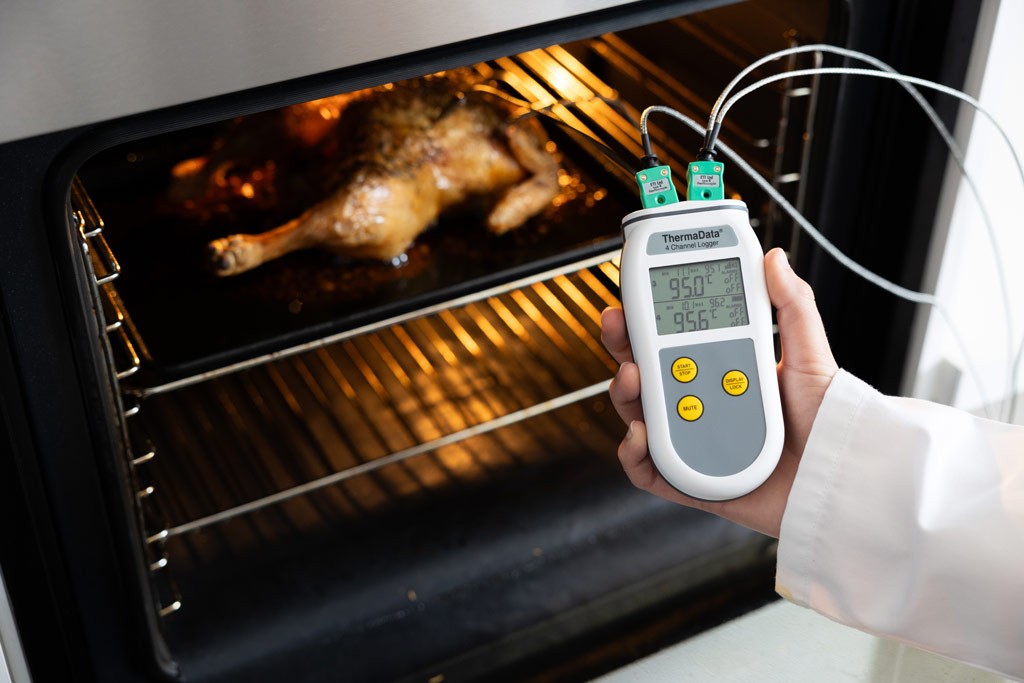Are We Overcooking Chicken? A Temperature vs Time Investigation

As thermometer specialists, there’s no surprise we believe in cooking to temperature rather than time. A quick temperature check means you always know that your food is safe to eat without being overcooked and dry, especially when it comes to tricky meats like chicken, which is safe and succulent once it reaches 74 °C.
Cooking times are notoriously unreliable because they depend on so many factors. Oven temperatures can become inaccurate over time, the starting temperature of your meat will vary depending on whether you cook it straight from the fridge, and your oven may cook more slowly if you have multiple dishes inside at once.
Cooking temperatures are how we know food is safe. Cooking times are simply an estimation of how long it takes to reach these safe temperatures. So, if 74 °C is how we know chicken is definitely safe to consume, how do supermarkets determine how long this will take considering all of the factors in play? If they don’t overestimate it, some chickens may not reach a safe temperature.
We decided to conduct an experiment on four whole supermarket chickens to find out if our hypothesis that cooking times are overestimated is correct, and if so, how much by.
What were we trying to find out?
How much packet instructions overestimate the cooking time for chickens.
How did we test it?
By monitoring the internal temperature of four whole chickens as they cooked. The recommended cooked chicken temperature in the UK is 74 °C. Using a data logger, we were able to see how long it took each chicken to reach 74 °C before reaching the end of the cooking time indicated on their packaging.
How did we control the test?
We purchased four small chickens, each from a different popular British supermarket — Sainsbury’s, Waitrose, Tesco and Lidl. We aimed for similar weights among all of the chickens. The oven temperatures on the chickens varied slightly between each, but we cooked each one using the temperature instructed on their packaging. We cooked each chicken one at a time, without any other food in the oven to prevent a fluctuation in oven temperature.
To monitor the internal temperatures of the chickens, we used our ThermaData 4 Channel Logger: a powerful and accurate thermometer with the ability to log temperatures from up to four different probes at once. Designed, made and calibrated by hand at our factories in the UK, it was a reliable choice for our experiment.
The temperature of a whole chicken can vary throughout, so we used three miniature needle probes across the thickest parts of the chicken. We took the final data from the lowest-reading probe because chicken is only as safe as its lowest temperature.

What were the results?
Cooking times
On average, the chickens had a packet cooking time of 87 minutes and 30 seconds. However, the average time they took to reach 74 °C was 44 minutes and 30 seconds, meaning they were in the oven for 43 minutes longer than necessary. This means that the cooking times were overestimated by an average of 96.6%. Sainsbury’s and Waitrose were the least overcooked time-wise, coming in at 35 and 31 minutes. Lidl and Tesco, however, far surpassed this by spending 56 and 50 minutes longer in the oven than needed.
Cooking temperatures
It goes without saying that the higher the temperature, the drier the chicken. On average the chickens reached 93.7 °C as they were taken out of the oven, 19.7 °C higher than necessary. Despite being one of the most overcooked in terms of time, the Tesco chicken reached the lowest temperature at 92.1 °C. Coming in next was Waitrose at 93.5 °C, followed by Sainsbury’s at 94.3 °C and Lidl at 94.7 °C. On average, their temperatures exceeded the recommended 74 °C by 26.6%.
Energy savings
Because the chickens spent nearly double the length of time in the oven than needed, we decided to look into how much extra energy this uses. Based on current estimates that the average UK oven costs 71p an hour to run, cooking one of the whole chickens to the time indicated on the packet would cost £1.04, whereas cooking them to 74 °C would cost 53p. If cooking a roast chicken every Sunday for a year, you could save £44.10 by cooking to temperature instead of time.


Conclusion
The results of our experiment confirmed that packet instructions overestimate the time that whole chickens need to be cooked for by almost double. Of course, food safety is crucial, and if our oven was inaccurate or we were cooking other dishes during our experiment it may have taken longer for the chickens to reach temperature. Therefore, we understand why the times are overestimated and we wouldn’t encourage cooking to shorter times without using a thermometer.
However, in the interests of food quality and enjoyment, reducing food waste and saving energy, we believe cooking temperatures would be a great addition to packet cooking instructions. Providing cooking temperatures in an accessible location and raising awareness of how this benefits food safety and quality will enable more home cooks to have confidence in their cooking and enjoy the results even more.

You might also like:
6 Tips for Safe Food Storage — Keep Food Fresher for Longer
The Ultimate Digital Thermometer Guide — Types, Features & Probes
Top 5 Room Thermometers for Saving Energy